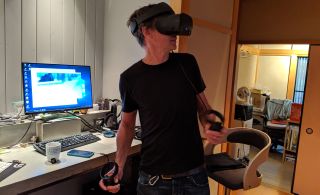Nature, history, and game development sit side by side in Kyoto
A stroll through the indie studios working in the heart of Nintendo country.

This is part two of a five-part series exploring PC gaming in Japan. The features originally ran in issue 335 of PC Gamer UK. We'll be publishing a new one each day this week, so be sure to come back for more of Wes' roadtrip.
A few hours on the Shinkansen from Tokyo and you’ve left behind a city of 14 million people and the bulk of Japan’s big game studios. But what Kyoto lacks in size it makes up for in heart and history. This is the home of Nintendo, neighbour of Capcom’s Osaka, and the capital of Japan for a thousand years. Take a 20-minute stroll from Nintendo’s headquarters and you’ll be at the foot of the Fushimi Inari shrine, built about 500 years ago.
History lives comfortably side-by-side with modern business, and the utterly relaxed, contemplative atmosphere that it gives Kyoto is probably why it’s home to Japan’s most prominent indie studios founded by foreigners. Once you’re there, it’s simply hard to leave.
“Greatest city in the world,” says Mark Lentz, who does PR and sound design for Q-Games, makers of the PixelJunk series. The studio, founded by former Star Fox programmer Dylan Cuthbert, has been in Kyoto for nearly 20 years. The younger 17-Bit, founded by Sega veteran Jake Kazdal, has only been in Kyoto since 2014, but they’ve found their home. Literally—the studio is set up in a sun-soaked house on a quiet residential street, which takes me past gaggles of seven-year-olds walking home from school in adorable hats and uniforms.
“Having access to all of the amazing natural beauty around here has been super inspiring,” says Kazdal. 17-Bit’s next game, after 2015’s underrated roguelike Galak-Z, is still under wraps, but Kazdal will tell me it’s set in the woods and built in Unreal Engine 4.
“I spend a lot of time hiking and camping. The nature here is just phenomenal,” he says. “It’s super weird and dense. All kinds of weird plants, interesting rock formations, a lot of canyons and valleys. Constant visual stimulus, I think, is huge.”
Spotlight on Kyoto
17-Bit, like the other indie studios in Japan, is mostly made up of American and British developers who’ve moved to Kyoto and settled. He says that thanks to events like Bitsummit, which puts the spotlight on Kyoto every summer, Japanese indies are starting to pop up more, but they still lag behind the west. Most Japanese developers still get a job at a company and stay there for decades, and few have applied for jobs at 17-Bit. “This is something that’s stumped me since I got here,” he says. “Japan has a huge history of entrepreneur-style restaurants and bars and little shops. Boutiques, bistros. Banks fund that sort of thing. That kind of entrepreneurship is prevalent everywhere. For some reason that doesn’t bleed into the tech. At all. Everything tech here is just giant corporations. I can’t figure out why. I don’t really understand. But I guess the systems have just sort of grown up around that, and that’s just the way things are.”
The biggest gaming news, reviews and hardware deals
Keep up to date with the most important stories and the best deals, as picked by the PC Gamer team.
Kazdal is a rabid VR player, so he sends me across town to Vitei Backroom, where Giles Goddard, who programmed beloved Nintendo 64 games like 1080 Snowboarding and Mario 64, is tinkering with a VR snowboarding successor. Rift and Vive controllers are strewn around the office like candy.

It’s mostly empty at 4pm on a Friday, but a couple of Vitei’s developers are racing to finish a new prototype before Bitsummit kicks off on Saturday.
It’s a cute, chunky toy train sandbox called Tinker Trains, where you place tracks, roads, and other parts on a map in tiles and then watch your little red train cars trundle happily along.
It looks like a real toy set, and there’s a great physicality to it. Designer Peter Traylor uses a pair of Nintendo Switch joy-cons connected to his PC to pick up the blocks and rotate them with motion controls. There’s a piece of track with a balloon on it, for example, that has a dial on the bottom to adjust its power. Turn your wrist and a screwdriver will flick between the notches, powering up the balloon to launch a train over a line of trees.
Goddard’s own pet project is a multiplayer VR snowboarding game, a shared mountain for dozens of boarders to carve down in real time. For now, both games are just prototypes. That’s life at an experimental indie dev. If they can find a publisher interested in funding them, the games will get made. Otherwise, it’s onto the next idea.

Wes has been covering games and hardware for more than 10 years, first at tech sites like The Wirecutter and Tested before joining the PC Gamer team in 2014. Wes plays a little bit of everything, but he'll always jump at the chance to cover emulation and Japanese games.
When he's not obsessively optimizing and re-optimizing a tangle of conveyor belts in Satisfactory (it's really becoming a problem), he's probably playing a 20-year-old Final Fantasy or some opaque ASCII roguelike. With a focus on writing and editing features, he seeks out personal stories and in-depth histories from the corners of PC gaming and its niche communities. 50% pizza by volume (deep dish, to be specific).
Most Popular

